
New Drivers for Food Delivery
An evolving array of digital delivery models is creating more options for consumers, retailers, and CPG companies—but not without a few bumps in the road.
Article Content
Home delivery connected to e-commerce is the key business driver of the moment—and probably for the future—for grocery retailers, CPG brands, and the start-ups that created the trend in the first place.
Big retailers ranging from Walmart to Target, Kroger to Meijer, are trying to reverse the “last mile” with delivery schemes. Giant food companies from Coca-Cola to ConAgra are testing platforms, too. Tech entrepreneurs are leaping into the white space to work their digital magic in the trail of Amazon. The entire food supply chain is turning on its head to focus on individualized delivery instead of the mass come-and-get-it model that characterized the previous era.
By 2025, in fact, online grocery shopping and delivery is expected to become a $100-billion-a-year business in the United States and comprise 20% of the overall grocery trade, according to the Food Marketing Institute and Nielsen. Every week seems to bring news of either a game-changing development—such as Amazon’s announcement in February of a two-hour Prime Now food delivery service via the Whole Foods Markets chain it purchased last year—or a wrinkle that promises to advance the trend from the margins, such as President Trump’s quickly derided proposal to convert food stamp fulfillment to a federal perishable goods delivery program.
“We are on the cusp of a major split between two types of shopping,” says Bill Bishop, chief architect of Brick Meets Click, a consulting firm. “It will be critical for grocers and suppliers to do two things simultaneously: address their vulnerabilities and find ways to leverage their strengths into increased spending online.”
Ken Harris, managing director of Cadent Consulting and a veteran adviser to CPG brands, agrees that the “delivery dynamic” will be “game-changing.”
“Some supermarkets will be in the driver’s seat, but delivery will roll over others,” Harris says. “And when it comes to CPG brands, they have to be engaged now and [be] learning and be part of the migration to the new standard because otherwise you’re going to get rolled and lose touch.”
The industry is finding plenty of rotten apples as it’s being reshaped by delivery. Consumers aren’t happy when delivery services pick out their own produce, for instance. Many still perceive online groceries as more expensive, because of delivery fees, than those at their neighborhood supermarket. And the delivery of meal kits already has run into problems (see sidebar below). Overall, in fact, the percentage of shoppers who tried online grocery shopping and were dissatisfied grew to 27% in 2017 from 17% a year earlier, a Morgan Stanley study showed.
Still, changing consumers are pushing the paradigm shift, especially the Millennial generation that is redefining practically everything in the marketplace. “Shoppers are less willing to make tradeoffs,” says Elley Symmes, analyst for Kantar Consulting in Boston. “They’re looking for added convenience in their lives, and that’s what’s really driving loyalty for delivery platforms.”
But as in other areas of digital life, technology is setting the pace. Pure-play start-ups have been driving the action in delivery since Peapod blazed a trail during the “dot-com” revolution, in the Internet’s early days, and established grocery-delivery services in Chicago and some other markets. More recently, Amazon created a consumer craze for delivery of all sorts of consumer goods, then launched Amazon Fresh in 2013 to extend its expertise and offerings to food.
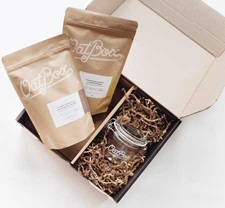 New Digital Delivery Models
New Digital Delivery Models
Now a new generation of digital start-ups is redefining food delivery. Brandless, for instance, has set up a sort of dollar store online: Every item it delivers costs $3 and is indeed unbranded, ranging from virgin coconut oil to body scrub. Marquee names such as Blue Apron and Hello Fresh have created the delivery meal kit category, one that also has drawn niche players such as Oatbox, which ships subscription granolas and other breakfast offerings, and Veestro, which delivers a menu of frozen fare made only from plants.
Yummy is an online start-up in Los Angeles that may be the future of grocery delivery, but it actually went into business in 2002. Built steadily and profitably over the years without venture financing by CEO and co-founder Barnaby Montgomery, Yummy now operates six locations in metro Los Angeles that fill almost 30,000 orders a month. Yummy delivers to homes within about 30 minutes of order placement, situating stores and organizing routes so that customers are no further than 15 minutes away. The service charges $6.99 for a minimum $15 order and offers free delivery for orders of $125 and more.
Montgomery says Yummy already is more convenient than stopping by a supermarket and is working toward his other two main goals: delivering the same groceries at a lower overall price than in a store, and eventually offering a superior assortment. For now, Yummy’s business model depends on super-efficient order picking, which is possible because the stores are under 5,000 square feet, selection is limited across all categories, and the work flow is organized so that employees with even minimal training can execute well.
“Our strategy is to develop solutions that are better than a trip to the store,” Montgomery explains. “We’re not an incumbent grocer trying to protect the store, although consumers can shop our stores too.”
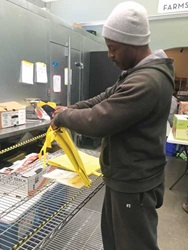 Up the coast in San Francisco an alternative approach is illustrated by a much younger company, Farmstead, which was established last year and has attracted $2.8 million in Silicon Valley financing. This start-up offers online customers a “curated” array of locally produced milk, eggs, yogurts, breads, produce, and other products totaling only 1,500 SKUs. Orders are picked at two, 2,000-square-foot “microhubs” and delivered for free on a weekly basis, or in any amount for $4.99 within one hour and $3.99 within three hours, on routes algorithmically laid out to be as traffic-free and eco-friendly as possible.
Up the coast in San Francisco an alternative approach is illustrated by a much younger company, Farmstead, which was established last year and has attracted $2.8 million in Silicon Valley financing. This start-up offers online customers a “curated” array of locally produced milk, eggs, yogurts, breads, produce, and other products totaling only 1,500 SKUs. Orders are picked at two, 2,000-square-foot “microhubs” and delivered for free on a weekly basis, or in any amount for $4.99 within one hour and $3.99 within three hours, on routes algorithmically laid out to be as traffic-free and eco-friendly as possible.
Reducing food waste is a primary goal of Farmstead for both practical and environmental reasons. The company’s artificial intelligence platform calculates and predicts users’ habits to know exactly how much food to order from local sources daily, weekly, seasonally, and annually. That saves Farmstead lots of money and plays well with the Bay Area’s environmentally attuned consumers.
“The reason that supermarkets waste a lot of food isn’t a systemic problem of moving food through the system but rather that there are people in every single department who are doing buying manually and making guesses,” says Farmstead CEO and co-founder Pradeep Elankumaran. “Our AI system cuts our food waste to under 10%, whereas at the traditional supermarket, food waste can be 35% to 40%.”
Grocery Retailers Respond
Faced with such threats from the digital-tech realm, many supercenter chains and major supermarkets recently have gotten aggressive in moving to reshape their business models around the delivery imperative. Most conventional food retailers now are reckoning with at least a complementary role for delivery as part of an entire rethinking of their supply chain and retail experience that also involves curbside pickup, in-store meal kits, and expanded on-site foodservice.
They’re trying to exploit their physical presence and integrate e-commerce to create synergies that make them viable in all channels. “The store will continue to be the entry into a larger ecosystem, whereas before it was a place to sell a bunch of stuff and have people come in and get that,” Symmes says. “Now stores are bringing them in to be part of a large ecosystem they’re building.”
Grocery giant Royal Ahold acquired Peapod in 2001. Now, more dependent than ever on a grocery trade that it has expanded dramatically over the last few years, Target has acquired Shipt, a delivery outfit. Walmart is using Silicon Valley to give trial to a service with tech company August Home in which workers can even unload deliveries in a customer’s freezer or refrigerator. 7-Eleven is testing delivery and in-store pickup via a smartphone app. Kroger was rumored in January to be a bidder for bulk-products deliverer Boxed and has even talked with Chinese Internet giant Alibaba about forming an alliance to counter Amazon.
Typical is what’s happening at two retailers headquartered in Grand Rapids, Mich.
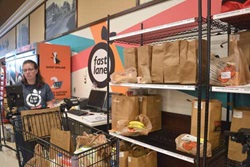
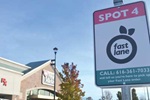 SpartanNash operates about 150 supermarkets and also is a major grocery distributor to chains across the United States. It launched curbside pickup in a few dozen stores last year and in November debuted a home-delivery service through a store in Michigan. “Our long-term goal is to have all options available” to customers, says Brian Holt, vice president of marketing. But “it takes time to implement it throughout our company footprint.”
SpartanNash operates about 150 supermarkets and also is a major grocery distributor to chains across the United States. It launched curbside pickup in a few dozen stores last year and in November debuted a home-delivery service through a store in Michigan. “Our long-term goal is to have all options available” to customers, says Brian Holt, vice president of marketing. But “it takes time to implement it throughout our company footprint.”
Meijer is one of the original supercenter discounters and now runs 235 stores in Michigan, Illinois, Indiana, Kentucky, Ohio, and Wisconsin. It offers home delivery via Shipt out of nearly 200 stores; Shipt already has handled more than one million orders. In time for last Christmas, Meijer also quickly expanded its menu to include deliveries beyond food and consumables to light bulbs, batteries, toys, and electronics.
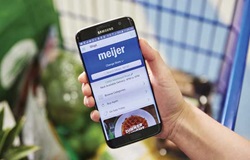 “Customers can order right from their local Meijer’s store that is close to home,” says Art Sebastian, Meijer’s vice president of digital shopping. “So they’re getting really fresh products from our store right to their door.”
“Customers can order right from their local Meijer’s store that is close to home,” says Art Sebastian, Meijer’s vice president of digital shopping. “So they’re getting really fresh products from our store right to their door.”
Delivery may benefit small and regional players over larger chains because “they’re a bit more nimble in their ability to respond and in how their customer bases are really loyal,” Symmes says. But it’s easier for big players to leverage tech advantages. Kroger, for instance, has a data analytics unit of 500 people called 84.51°—for the longitude of Kroger’s Cincinnati headquarters—that it acquired in 2015.
Personal Shoppers Hit the Supermarket
Lots of companies are assisting retailers in fording the digital divide. For example, ShopperKit helps grocery chains fulfill online orders for pickup from in-store inventory. The software platform enables store employees to pick efficiently off the shelves and creates a communication channel with customers who may have questions about their order.
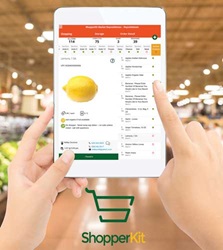 “The customer wants to shop their local store, and they’ll go there at least twice a week even if they also take deliveries,” says Jack Record, CEO of Atlanta-based ShopperKit. “They’re happy to send us a text and say, ‘I’m on my way,’ and the store has the order outside waiting for the customer. It’s a seamless process.” And anyway, “How comfortable are most consumers with having strangers putting their food in a car and taking it to their house?”
“The customer wants to shop their local store, and they’ll go there at least twice a week even if they also take deliveries,” says Jack Record, CEO of Atlanta-based ShopperKit. “They’re happy to send us a text and say, ‘I’m on my way,’ and the store has the order outside waiting for the customer. It’s a seamless process.” And anyway, “How comfortable are most consumers with having strangers putting their food in a car and taking it to their house?”
Obstacles abound as chains try to construct these new ecosystems. One of the biggest is that 84% of consumers recently surveyed by Morgan Stanley prefer to see and choose their own grocery items, a percentage that was unchanged from 2016.
This challenge is most evident with produce, of course. “It can be as simple as the difference between a yellow and green banana,” says Meijer’s Sebastian. “And whether you’re looking for ripe bananas for today versus some you need for three days from now.”
Delivery services and retailers are investing huge resources to address this objection. Shipt and Instacart are using training, branding, and messaging, referring to workers as “personal shoppers” and allowing customers to communicate with these individuals even as they’re gathering products.
In order to invest capital wisely, supermarket chains also need “to figure out the cannibalization question,” says Kantar’s Symmes. “How do they forecast how the shopper may be drifting between in-store and online purchases?” And in that regard, many chains are going to have to repurpose the real estate involved in store transformations—or closings—as delivery reshapes the industry.
Digital Delivery Domains for CPG Companies
In seeking to make their own deep footprints in home delivery, most CPG brands are starting in a big hole: Only 6% of CPG companies even have a dedicated e-commerce supply chain team, and only 3% are able to fully track sales by channel, according to a new study by Boston Consulting Group that was commissioned by the Grocery Manufacturers of America.
But most big brands are trying to play catch-up for working with online retailers or doing their own deliveries. CEO James Quincey recently told investors that “the large majority” of the company’s business is always going to “go through [retailer] platforms,” but Coca-Cola is experimenting with direct-to-consumer methods. PepsiCo has created a 200-person business unit to develop e-commerce marketing and packaging for online sellers, placing headquarters in Manhattan with its hordes of tech workers.
Tyson Foods launched kits through Amazon Fresh in 2016, working its chicken and beef into tacos, stews, and roasts. ConAgra’s Chef Boyardee brand joined with Peapod to sell kits for Buffalo chicken quinoa and zucchini noodle primavera, incorporating ConAgra products such as Hunt’s tomato sauce and Rotel queso dip. Barilla Pasta was one of the first CPG brands to recognize the potential of the meal kit market, in 2015 debuting with a meal kit menu through Peapod.
Campbell Soup is testing an online service that will deliver soups to customers’ doors, shipping out premium products that consumers can heat up at home. The company already has made forays into e-commerce via Amazon and other fulfillment services, where its chili macaroni and chicken noodle soup are among best-sellers. But the company is testing a direct link with shoppers, setting the stage for customers to browse for packaged soups on Campbell’s website and having them shipped from its warehouse directly to their front doors.
And in the biggest CPG gambit in delivery to date, Campbell invested in Chef’d. So did meat producer Smithfield Foods. Other CPG companies also are experimenting with e-commerce-based investments. For instance, Unilever’s venture capital arm just invested in Sun Basket, an organic meal kit delivery service in San Francisco.
New Models, New Approaches
Some companies that started up in other tech sectors have veered heavily into food delivery. Though it began as the creator of mass urban ride-sharing for humans, for example, Uber now earns more than half its profits by delivering goods rather than people. Unilever launched a new brand of its Magnum frozen novelties only on Uber, hiring drivers to deliver them for free to consumers.
As they test delivery platforms, brands also must rethink marketing budgets and reallocate resources to digital domains and away from traditional ways of reaching consumers such as TV ads, flyers, and in-store endcaps. “They need to be sponsoring promotions on Peapod or Kroger Quick list, and on a mass scale, so brand visibility is omnipresent and able to intersect shoppers across all channels,” Symmes says.
Like everything else disrupted by the Internet, delivery will wreak failure on many players and trip up others. For example, Habit, a “personalized nutrition” service established by Plum Organics founder Neil Grimmer, decided to “pause” its test food-delivery program in the San Francisco Bay Area last year “to assess its options to scale food delivery beyond the local market,” including a possible nationwide meal delivery program.
And Hershey, while eager to sell direct to consumers, remains confounded by home delivery because, well, chocolate melts easily. “That last mile to the customer is a real challenge for us,” says Brian Kavanagh, director of insights-driven performance and retail evolution for the confectionery giant.
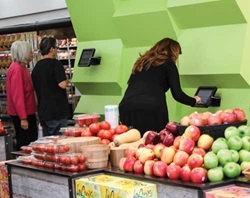 Bishop foresees two viable models for the future of delivery. One of them is the Yummy approach of serving ad hoc consumer needs with efficient, delivery-oriented stores each serving a small geographic area. Bishop envisions this model using increasingly sophisticated robots to replace humans even for picking individual items from shelves.
Bishop foresees two viable models for the future of delivery. One of them is the Yummy approach of serving ad hoc consumer needs with efficient, delivery-oriented stores each serving a small geographic area. Bishop envisions this model using increasingly sophisticated robots to replace humans even for picking individual items from shelves.
The second model is the one pioneered and perfected by Amazon—and perhaps not replicable by any other company. This model was initiated with Amazon Fresh, accelerated with the launch of its Prime subscription platform, and fully dimensionalized in the purchase of Whole Foods. It’s also similar to the model that was popular in Twentieth Century America in regular home deliveries of milk, bread, and newspapers.
“You establish enough confidence on the part of buyers to be able to have a significant number of households that buy both packaged and fresh products, and you build a distribution system that is highly structured and served routinely,” as Bishop puts it. “So you eliminate one-off distribution and dramatically improve the efficiency of serving any individual household. Then you can load on anything else you want to sell.”
Still, warns Harris, “Hyperbole about delivery is moving at the speed of light, and reality is moving at the speed of snow. That’s the hard part. It’ll take five to 10 years for everything to change.”
The IFTNEXT initiative is a heightened, purpose-drive commitment to bringing provocative ideas and discoveries together to inspire thoughtful, important conversations that challenge conventional approaches with the goal of informing global issues related to the science of food.
Cooking Up Success in the Meal Kit Business Is Not So Simple
Hello Fresh has been running TV advertisements aimed right at the target demographic for its meal kit delivery services: harried Millennials. In one ad, Danielle Moulton, an emergency medical technician with “mom guilt” about fixing meals for her two young daughters, says that Hello Fresh has “literally come to our rescue” by providing kits that give her “pride in what I’m serving my kids.”
Trouble is, there haven’t been enough Danielle Moultons for meal kit services to avoid a rough patch as their industry attempts to slip into the American culinary mainstream. There are lots of meal kit start-ups and experiments, but some of the best known are struggling financially and with sales growth, including Hello Fresh and Blue Apron.
“The patina has worn off the home delivery kit,” says Ken Harris, managing director of Cadent Consulting.
Four challenges have confronted this young category. The first is over-proliferation. About 150 new meal kit companies have been founded in the last five years, many in very narrow niches, according to Packaged Facts, a consultancy. As the field has gotten more populated, investors have grown cautious. Last year, around $274 million was invested in meal kit companies, down from a peak of 25 deals worth $308 million in 2015, according to data provider PitchBook Data.
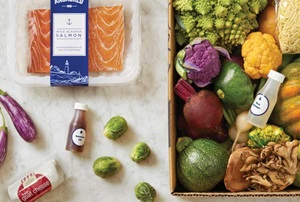 The second obstacle is the high cost of acquiring and holding on to customers. Blue Apron has spent as much as $100 to acquire a customer, according to regulatory filings for its initial public offering. “It comes down to customer-acquisition costs versus the lifetime values of customers, and those values are really challenged even after they’re acquired by those kinds of costs,” says Sean Butler, retail director of meal kit specialist Chef’d.
The second obstacle is the high cost of acquiring and holding on to customers. Blue Apron has spent as much as $100 to acquire a customer, according to regulatory filings for its initial public offering. “It comes down to customer-acquisition costs versus the lifetime values of customers, and those values are really challenged even after they’re acquired by those kinds of costs,” says Sean Butler, retail director of meal kit specialist Chef’d.
Apropos of that: An estimated 70% of customers of Blue Apron, the largest provider, stop regularly buying its meals six months after signing up, while more than 80% of Hello Fresh users weren’t active, according to Daniel McCarthy, an Emory University professor who researches meal kits and other subscription services. In February, Blue Apron reported that it had lost 15% of its customers from a year earlier.
“They are just draining themselves with marketing spending and not getting retention from consumers,” says Elley Symmes, analyst for Kantar Retail. “It’s not becoming routine for them.”
That complication is related to the third problem for meal kit companies: in a sense, trying to fit a square peg into a round hole. The best meal kit customers lead relatively routine and predictable lives or demonstrate the highest need for help cooking at home—they tend to be single Millennials, empty-nest Baby Boomers, or the elderly.
Millennial parents like Moulton are the holy grail for meal kit marketers but, realistically, many of them simply can’t accommodate subscription food plans when their lives are crazy quilts of dual jobs, kids’ activities, work and leisure travel, and other demands. “They’re not seeing parents with young kids taking this on, and the price point is a little high anyway,” Symmes says. “People aren’t willing to pay it.”
At the same time, many customers of all demographics quickly find that their lives don’t fit neatly into the subscription plan business model followed by many meal kit providers. Kits may pile up unused for a few days, and customers give up.
“Some people are highly motivated and intentional,” says Bill Bishop of consultancy Brick Meets Click. “But people go out to eat a lot, so the ability to maintain a subscription model is tenuous.”
The fourth challenge for meal kit companies is competition from supermarkets, which are more than happy to broaden their service element by delivering meal kits and by providing them for pickup in their stores—or fixing meals that customers can wind up enjoying on the premises.
“Retailers are the ones who have the ‘right to win’ here,” Harris says. “They’re just repurposing inventory and taking stuff they already buy and making kits out of it. It’s an effective and efficient use of resources.”
Still, some meal kit brands profess to be profitable. Home Chef, for instance, says it’s remained in the black while growing in just two years from delivering only 70,000 meals a month to nearly 2.5 million meals a month today. In part, the company credits acquiring customers through traditional advertising on TV and radio in addition to digital marketing.
And meal kits are projected to grow to more than $6 billion in sales in 2021 from around $2 billion in 2016, according to consultancy Pentallect. What companies will enjoy the boom is an open question.
How Chef’d Wins in the Meal Kit Game
Chef’d has positioned itself to benefit from the delivery revolution no matter where it goes. The El Segundo, Calif.–based start-up is knee-deep working with major retailers and big CPG brands even as Chef’d navigates an independent path.
At the core of these diverse expressions of its business model is the belief that meal kits, maybe in various shapes and forms, are the future of the grocery-fulfillment business.
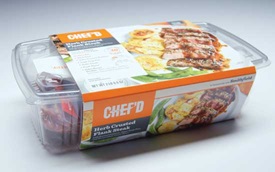 “Shoppers increasingly are looking to purchase food in meals,” says Sean Butler, retail director for Chef’d (pronounced “sheffed”). “You see that in a lot of different ways. For example, foodservice is the No. 1 growing channel in traditional grocery retail. And there’s the initial success of meal kit companies in e-commerce. No matter where you look, you see behavior transitioning from ingredient purchasing to meal purchasing.”
“Shoppers increasingly are looking to purchase food in meals,” says Sean Butler, retail director for Chef’d (pronounced “sheffed”). “You see that in a lot of different ways. For example, foodservice is the No. 1 growing channel in traditional grocery retail. And there’s the initial success of meal kit companies in e-commerce. No matter where you look, you see behavior transitioning from ingredient purchasing to meal purchasing.”
So far, Chef’d has managed to avoid the woes of some other meal kit companies. For one thing, its delivery business doesn’t rely on meal kit subscriptions but allows consumers to order whenever they want and whatever they want from a selection of about 1,000 breakfasts, lunches, and dinners.
Also, the company spends relatively little marketing its product, letting its relationships with big partners—which often are co-branded—create awareness for Chef’d.
Chef’d is trying to go neck-and-neck with Amazon in terms of timely fulfillment of online orders for a number of supermarkets and CPG brands. But it’s also got a huge and growing footprint inside grocery stores, having launched meal kits under retailers’ private labels inside more than 100 stores in about a half dozen states, with many more to come. Instacart, Shipt, and other services also deliver Chef’d meal kits from stores.
“We’ve designed this program so in-store and delivery are complementary,” Butler says. “Our market research has indicated that shoppers buying retail meal kits are more than 50% of the time consuming the kits that same night, and more than 85% the first two nights. That’s different than e-commerce.”
So Chef’d makes about a half dozen different meal kits available for in-store purchase, about 30 to 40 recipes available for same-day delivery from that store, and all 1,000 varieties available for delivery within a few days.
“We just handle it on the back end for stores,” Butler explains. “They handle the credit-card data management, and we’re able to extend their brand equity all the way on the journey to the consumer by shipping these products in co-branded boxes.”
Chef’d’s initial partnerships with CPG brands were serving as the “buy button” for recipe kits on websites for Coca-Cola, Nestlé, and others. But over the last couple of years, Chef’d also has collected $35 million in investments from Campbell Soup and Smithfield Foods.
In exchange for experimentation with Campbell in a variety of direct-to-consumer applications, meal kit fulfillment on Campbell’s website, and the chance for Campbell to experiment with ingredients in Chef’d kits, Chef’d gets “a wealth of traditional marketing expertise and consumer research,” Butler says.
Smithfield’s focus with Chef’d is in bricks-and-mortar retailers, through dedicated endcap coolers in more than 100 stores and shopper marketing about their partnership, while Smithfield’s airtight refrigerated distribution system carries outbound Chef’d meal kits.
Chef’d also is pioneering in distribution technology with a patent-pending packaging system that, Butler says, “gives us 16 days of [shelf] life after the point of putting together the recipe, compared with the usual eight days.”
Domino’s Tests Driverless Pizza Delivery
It practically created meal delivery. And now, decades later, the pizza industry is back on the cutting edge of meal delivery.
Foodservice is exploding with delivery options and experiments, of course, but Domino’s and Pizza Hut are among the very few restaurant brands that have presented credible experiments in self-driven delivery vehicles.
Domino’s experimented in its home town of Ann Arbor, Mich., last fall with Ford using an autonomously driven Fusion Hybrid sedan packed with researchers who wanted to see how the vehicle conducted itself—and how customers interacted with it.
Among their learnings: Customers want to say “hi” to the vehicle, regardless that it’s a machine.
Meanwhile, Pizza Hut is teaming up with Toyota to develop platforms that may lead to self-driven delivery vehicles that also cook pizzas en route.
If this seems like a trivial pursuit, think again. “If you look at the total number of miles being driven today by our system, we’re probably one-third to one-half the size of the total miles driven by Uber,” says Patrick Doyle, CEO of Domino’s—which, of course, pioneered the quick delivery that revolutionized his industry.
“Is there a way to do that more efficiently?” he wonders.
Dale Buss is a freelance writer based in Rochester Hills, Mich. ([email protected]).
IFTNEXT is made possible through the generous support of Ingredion, IFT’s Platinum Innovation Sponsor.





